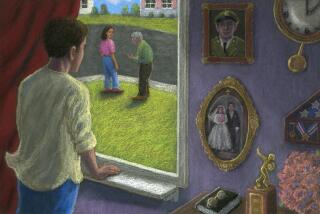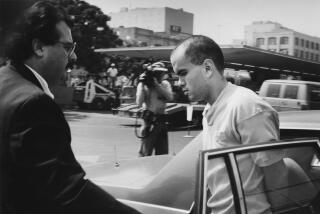More than 1,000 pages of documents reveal Sandy Hook shooter Adam Lanza’s dark descent
- Share via
Reporting from newtown, Conn. — The extent of Adam Lanza’s abject loneliness, the intensity of his scorn for the world, his interest in pedophilia, his astounding list of daily grievances, the reach of his obsession with mass murder — some of the granular details of the Sandy Hook shooter’s last years have been elusive.
Until now.
More than 1,000 pages of documents obtained by the Hartford Courant from the Connecticut State Police, including hundreds of pages of Lanza’s own writings and a spreadsheet detailing the gruesome work of 400 perpetrators of mass violence, bring into sharper focus the dark worldview of a 20-year-old who shot his mother four times as she slept and then killed 20 first-graders and six educators before killing himself at Sandy Hook Elementary School in Newtown on Dec. 14, 2012.
Diagnosed as a child with a sensory disorder and delays in speech, he would exhibit a quick mind for science, computers, math and language. The few acquaintances he had as a teenager came from video-game arcades and online gaming chat rooms. The newly released writings express a wide range of emotions and rigid doctrine, from a crippling aversion to the dropped towel, food mixing on his plate and the feel of a metal door handle, to a deep disdain for relationships, an intolerance of his peers, a chilling contempt for anyone carrying a few extra pounds and a conviction that certain aspects of living are worse than death.
At the same time, he also predicted that he would make a good father because he would treat children as independent little people who just didn’t know a lot yet. In a memo-style letter to his mother, Nancy, who lived in the same house, he encouraged her not to be dejected about her life.
These documents, which had been kept from the public until now, were part of the mass of writings, records and computer files seized by detectives from the Lanzas’ home after the killings. The Courant mounted a five-year quest to obtain the unreleased documents, eventually winning an appeal before the Connecticut Supreme Court.
From the journal entries, school assignments, a screenplay involving pedophilia, education records and psychiatrists’ reports spanning about 15 years of Lanza’s life, several parallel themes emerge, each moving inexorably toward the day when the emaciated loner, crippled by obsession, scornful of most other people and fascinated by the human capacity for murder, committed his unspeakable act of violence. Some of the writings and psychoanalysis are dated. Many are not.
The documents released by the state police aren’t in chronological order, and it’s unclear when Lanza wrote many of them. A number are unsigned. Lanza removed the hard drives from his computer and smashed them to pieces. The FBI was tasked with trying to retrieve data.
One thing becomes clear as the additional records are examined — Adam Lanza, from about age 3 to 18, was never off the radar of people who orbited him — his parents, the teachers and counselors in the schools he attended, the psychiatrists who later tried to figure out what was happening with him. It is evident now that no single person grasped the full picture of what he was becoming.
Isolation
Lanza would spend most of his life on the margins of society. He played Little League baseball, and the sheaf of photos among the newly released documents includes pictures of him posing in his uniform, bat poised. But he later disowned the experience and said he never liked it. By 14, he was already becoming a “homebound recluse,” a psychiatrist at Yale worried.
And from that point on, through his teens, the records suggest that his paralyzing obsessions, his raging germophobia that prevented him from touching door handles and other fixtures with a bare hand, and his rigid set of beliefs — not to mention the blacked-out windows of his bedroom and the countless hours he spent playing combat video games — would guarantee his place on the fringe.
His isolation had its roots in his developmental speech delays as a child, the first of a string of diagnoses that included obsessive-compulsive disorder, sensory integration deficit and autism spectrum disorder.
The boy was not yet 3, living with his family in New Hampshire, when he began to experience what it was like to be different, to have other preschoolers draw back from him, to be isolated.
“Adam’s parents said Adam’s speech attempts were not easily understood, and that Adam became quickly frustrated when others asked him to repeat himself.… Recently Adam reportedly began hitting, spitting and crying when he could not make his needs known,” began a speech evaluation of the 2-year, 10-month-old boy by the Sanborn, N.H., regional preschool program in February 1995.
The speech pathologist noted that “most of his speech attempts were unintelligible.… When not understood, Adam raised his voice volume and repeated the same utterance in a frustrated way. He did not attempt to supplement his speech [with] facial expressions, gestures or body movements to help his listeners understand him better.”
Another report a short time later noted that Nancy Lanza “was very concerned” about her boy’s continued speech delays, in part because he had stopped trying to talk in groups and was realizing that other children couldn’t understand him.
Adam Lanza’s parents separated when the boy was 9, and a mutual dependence developed between mother and son. Nancy Lanza maintained her busy social life, later supported by a $289,000 annual alimony payment, while Adam, six years younger than his brother, Ryan, spent much of his time in his bedroom or the basement of the large house in Newtown.
As a teenager, his sensory condition made him exceedingly sensitive to textures, sound, light and movement. He shunned his classmates, bothered by their choice of clothes and the noises they made. He cultivated a set of ground rules that fed his separateness.
In an eight-page communication written in Microsoft Word and titled “Me,” Lanza wrote, “Relationships have absolutely no physical aspect to me; all that matters is communication.”
The undated document appears to be a message to someone he was communicating with in a chat room. He added that he was drawn to this person because “you could actually type coherently.’’
He had barred his mother from his room and his basement lair and probably shared little of what he was writing on his computer.
His only points of reference seemed to be his own thoughts and his impersonal online relationships with those who shared similar ideas, said former FBI profiler Mary Ellen O’Toole, who reviewed some of the documents for the Courant.
In this way, “you could see how you slip further and further away from a balancing of what’s normal,” O’Toole said.
Tutored at home for a portion of his time at Newtown High, Lanza was already building a wall around himself. His mother would explain that she thought the Homebound program, usually reserved for students who were physically unable to attend school for a period of time, was good for her son, given his aversion to the chaos in the hallways of a large high school during the change of classes.
But a Yale expert, upon meeting Lanza for the first time, thought the isolation could be catastrophic.
“Are there kids you enjoy spending time with?” psychiatrist Robert King asked the 14-year-old Lanza during an initial evaluation at the Yale Child Study Center in 2006.
“Why would that be significant?” young Lanza answered, appearing to King as “pale, gaunt, awkward … and standing rigidly with his eyes downcast and declining to shake hands, tremulous with discomfort and looking miserable.”
Nancy Lanza piped up and said her son “was much more relaxed at home, and his stiffness and tension was due to being here,” King wrote in the eight-page summary of his evaluation.
“What is a friend?” King asked Lanza.
“It is difficult to define — in whose culture do you refer?’’ the boy answered, robotically.
The psychiatrist said Lanza was faced with “increasing social withdrawal and reclusiveness.” King reported that the teen’s at-home instruction created a harmful “prosthetic environment with no student encounters.” This was a recipe for Lanza to become a “homebound recluse,” said King, adding that it was a mistake to adapt the world to Lanza, rather than the other way around.
In other writings, Nancy Lanza laments that her son’s isolation was likely to get worse over time, in part because of poor relationships developed at school.
“One on one he is extraordinary. In a classroom setting he is performing well below age level,” she wrote. “Other children will tease him and undermine his confidence. He will learn to talk less, not more. Already some children are saying he’s weird when they don’t understand him. At this point he thinks it’s funny when they say that. As he gets older, he will realize that it isn’t.”
After high school, Nancy Lanza worked on a plan for getting her son into college, perhaps out of state. She predicted a “nightmare” experience for him in the dorms if he didn’t get a handle on his social paralysis, and said that he would need “scripts” to talk with girls and relate to the people around him.
Notes about looking ahead to college, which appear to have been written by Nancy Lanza, recommended that her son have an Individualized Education Program in place until age 21, which would have been a year after the Sandy Hook shooting.
The handwritten notes also mention the possible use of medications to help calm her son. A number of records obtained by the Courant indicate that doctors had prescribed or suggested Adam Lanza take medication over the years but that he would often refuse to take them or declined to be prescribed.

Obsessions
Lanza ruled over his own experience with an iron, unyielding hand. The slightest deviation from routine enraged and paralyzed him. He knew his compulsions and obsessions, spelled out in a scrawled, handwritten list titled “Problems,” had made life untenable for him, but he admitted he could do nothing about it.
“I am unable to distinguish between my problems because I have too many,” Lanza wrote.
In one document, Lanza, his aversion to being touched well-established, wrote about what he described as being raped as a child by doctors and more generally how he believed doctors sexually assault children routinely.
“Honestly, doctors touching my penis when I was a child was worse than it would be if I consented to an adult in a loving relationship with them,” he wrote in an undated document. “I don’t see how I and every child was not raped by doctors: We did not consent to it. We only did it because our parents made us. Which is another point: If we as a society taught children that they are independent of their parents and that they should not blindly follow them, they would not be abused by their parents in the way they often are.”
Lanza’s obsessive behavior is also described extensively in King’s evaluation, obtained by the Courant. The report is a startling chronicle of severe obsessional behavior and dire warnings of what would happen to Lanza should there not be appropriate intervention.
In the report, King wrote, “Adam has a variety of rigid controlling and avoidant behaviors which have been loosely described as OCD but seem to have several facets.” Lanza had “the rigidity of a youngster with autistic spectrum disorder” plus “sensory defensiveness” and “classical obsessive-compulsive features.”
Lanza was “intolerant if his mother brushes by his chair,” wrote King. He was upset when his mother leaned on something or if she walked too loudly. Lanza objected to how loudly she spoke on the phone and the smell of her cooking, which he mostly did not eat because of its texture.
Scorn for others
Lanza’s writings bristle with his disdain for people living normal or privileged lives: mothers and fathers, his classmates, athletes.
“I incessantly have nothing other than scorn for humanity,” he wrote in what appears to be an online communication with a fellow gamer. “I have been desperate to feel anything positive for someone for my entire life.”
Much of Lanza’s scorn was reserved for his parents, some of the documents reveal. In the 2006 Yale evaluation, King wrote “as for [Lanza’s] parents’ separation, Adam’s understanding was that they were irritating to each other as they are to him.”
The Yale evaluation noted that Lanza’s father, Peter, was living in Stamford, Conn., and that “Adam does not want to visit his father’s home for reasons that are unclear.” Adam was also “irritated” by his brother, Ryan, who at the time was a homesick Quinnipiac University student.
A common theme in the records is Lanza’s scorn for school and his classmates.
He stopped playing the saxophone in the school band, Lanza told King, because the students “all played badly. No one practiced. No one paid attention.”
The Yale evaluation noted that while Lanza was a careful reader, he had “no grasp of empathy for characters’ motives, feelings or perspectives.”
Lanza also wrote that he hated “fat people,” but it appeared that no one who ate a meal every day would have escaped his wrath.
Lanza himself was malnourished and emaciated when he carried out the shootings, according to Dr. H. Wayne Carver III, the then-chief medical examiner in Connecticut who conducted the autopsy.
Dr. Harold Schwartz, former director of psychiatry at Hartford Hospital and a member of the Sandy Hook Advisory Commission that studied the shooting, said that Lanza may have been starving himself and that his anorexia probably was hastening his mental as well as physical deterioration.
“You will be FAT if you eat today, just put it off one more day,” Lanza wrote in a list of 53 reasons to remain skeletally thin. The list appeared to be directed at someone he was communicating with online, perhaps a girl.
“People will remember you as the beautiful thin one,” he opined.
“Bones are clean and pure. Fat is dirty and hangs onto your bones like a parasite.… Eating is conforming to everyone’s expectations. Hunger is your friend and it won’t betray you like food. Have you ever seen a person NOT notice a walking skeleton?”
Yearning for connection
Even with years of isolation, there are strong indications in the documents released by state police that Lanza yearned for companionship. That yearning manifested itself in what appeared to be online communications with people he hoped to grow closer to and in notes for a chilling screenplay that detailed a relationship between a boy and man and included images of the killing of family members and gunplay.
In the same online document in which he expressed his scorn for humanity, he wrote to the fellow gamer: “Most of my social contact was through those players. All of them are typical detestable human beings, and it bred an aura of innumerable negative emotions for me. You were a respite from that.”
He said he felt a strong “affinity for people whom I perceive as being abused, and consummate scorn for the abusers.”
“I am capable of boundless affection. I had never been in a situation to feel that way before, so I thought that it was special…. I took my focus away from myself and directed it toward you,” Lanza wrote in the communication with the gamer.
Lanza’s most startling manifestation of his yearning for a connection is in the notes for a play with a theme of pedophilia and familicide. It is not clear whether the document had been seen by anyone other than Lanza.
“Two kids observing group of either goths, emos, or something like that. Discussing how cool they are,” he wrote. “Scene where the kids approach the goths. Kid’s friend tells him that he’s going to run away. 10-year-old hears about his friend who ran away. The kid tried doing something that an adult would have done, but was unable to because he was a kid. Eventually, the kid is found frozen to death, or something like that. Kids are playing together in some place.
“Kid either goes to place where pedophile is, or happens to come across him in public. Scenes where the kid talks to the pedo many times about his life. The pedo helps him. The pedophile either gets killed or goes to prison. Kid with the pistol laying back on his bed while cocking and clicking his pistol while listening to his father yelling condemning his sister who’s in a relationship with a boy. Scene where the kid finds out about a familicide.”
Lanza also wrote in a hopeful way of raising a family, albeit with another slap at what he apparently considered the too-restrictive nature of parenthood.
“I’m certain that I would be a phenomenal father because I would foster a free environment for my child. S/he would never do anything because I said so. Instead of treating her/him like a pet that can talk, I would treat her/him like a little person who doesn’t know very much. I would not subject my child to my opinions: I would encourage them to think for her/himself.”
And Lanza seems to describe a perfect companion:
“She needs to be contemplative, introverted, introspective, insubordinate, non-confrontational, able to communicate with me, and engage in banter. And I think I want her to be at least vegetarian.”
An ambivalent sexuality
Lanza’s attitudes about life and love softened when he wrote about pedophilia, which he describes as a nurturing type of love.
In the outline for a screenplay that he was calling “Lovebound,” he wrote that the script would portray “the beauty in the romantic relationship between a 10-year-old boy and a 30-year-old man.” The eventual film, he wrote, would be devoid of music or humor or any screen credits — only solemnity would remain.
“No, it’s not at all pornographic,” he added. “And it is not satirical. Nor metaphorical. Take it for what it is.”
In the outline, he asks, “is it really love if you’re not willing to romantically love a male the same way you would a female?”
The outline includes a detailed reference to a book about an experience in the young life of Austrian psychoanalyst Heinz Kohut. As a lonely boy controlled by his mother, Kohut developed a close relationship with an older male tutor and mentor who was hired by Kohut’s mother. Kohut reported that the rich intellectual relationship he had with his mentor ushered in the best years of his life and that the relationship eventually became sexual.
Schwartz said Lanza’s research into a scholarly psychoanalyst, little known outside the world of psychiatry and psychology, is a sign of his intellectual capacity. It also demonstrates that intelligence doesn’t protect you from being nearly or even completely delusional, Schwartz said.
Schwartz noted that the story about Kohut is “not much different than what Lanza’s screenplay notes portray.”
The notes and the Kohut story, “taken together, suggest what Lanza may have been longing for himself — to be saved by an older man who will first offer him companionship and then a sexual relationship,” Schwartz said.
In a list of desires, Lanza includes pedophilia, and he downloaded a study from the Mayo Clinic: “A Profile of Pedophilia: Definition, Characteristics of Offenders, Recidivism, Treatment Outcomes, and Forensic Issues.” The focus on pedophilia is recurrent in other documents.
Fascination with murder
The first hints of Lanza’s fixation with violence came when he was in fifth grade and he and another boy wrote the “Big Book Of Granny,” 52 pages replete with references to violence against children.
In one chapter, a character named “Dora the Beserker” enters a day-care center with “Granny” and her son. Dora at one point says to Granny, “Let’s hurt children.”
There’s a chapter where Granny slaughters people on the set of “Granny’s Clubhouse of Happy Children” and another that references a game called “Hide and Go Die.” The hand-drawn image of Granny surfaces also in a Mother’s Day card Lanza drew for his mom that is included in the documents.
Investigators from the Connecticut child advocate’s office, in their report, pointed to the Granny book as a giant missed opportunity to find out why Lanza was so easily able to conceptualize violent acts and draw them out in his stories until blood was shed. This fixation only festered as he got older and angrier and became more isolated.
There is no clear evidence how school authorities might have reacted to seeing the Granny story, Schwartz said. It is unclear whether anyone saw the book at the time it was written.
Schwartz said that Lanza’s fascination with the act of mass murder and his anger were undoubtedly building blocks but, by themselves, were not sufficient to explain the Sandy Hook shootings. Nor were Lanza’s isolation and obsessions.
While the combination clearly heightens the risk, one more factor would have to be present, Schwartz said — a lack of empathy and social connection so great that other people no longer seem real.
“In this mental state, known as solipsism, only the solipsist is real. Everyone else in the world is a cardboard cutout, placed there for your benefit and otherwise devoid of meaning or value,” Schwartz said. “It is the most extreme end of one form of malignant narcissism. If the victims have no value then there is nothing to constrain you from shooting them.”
Schwartz said the Sandy Hook commission, working with the information it had, was unable to declare that Lanza was psychotic by 2010. Little is known about Lanza’s mindset during the next two years leading up to the shootings, other than a further descent into isolation.
Before the Sandy Hook killings, Lanza had access to weapons and practiced firing a Bushmaster AR-15-style rifle on the range with his mother. The Bushmaster was his principal weapon during the massacre. He was also known to have edited Wikipedia accounts of mass shootings.
Among the newly obtained documents is further proof that Lanza was captivated by the act of murder. Recovered from his computer was a spreadsheet that Lanza produced over at least four years, from 2006 to 2010 — a list, chilling in its complexity, of mass killings dating to 1786.
In the spreadsheet, the killers are arranged not by date or alphabetically, but by numbers of people killed. The 17 columns of information include type of weapon, nature of the location, day of the week and fate of the shooter. The spreadsheet appears to have been last updated in 2010 or 2011. It does not include Anders Breivik of Norway, who killed 77 people in two attacks in July 2011.
“It’s as if he was looking to see where he would fit in on the list,” Schwartz said.
O’Toole, the former FBI profiler, said she was struck by the sterile, sanitized and precise nature of the spreadsheet, devoid as it is of any commentary, flourish or emphasis on one shooter over another.
O’Toole said this document took time, effort and commitment, and therefore was important to Lanza.
By the summer of 2012, Lanza appeared to dismiss the meticulous record, posting in a gamer chat room that he no longer cared about the rankings of mass killers. But the list belied his clinical fascination with the weapons and tactics of mass murder.
In his written communication with the gamer, he observes, “Early on, you referenced serial killing multiple times in ways people normally don’t.
“That immediately appealed to me,” Lanza said.
Kovner and Altimari write for the Hartford Courant.
More to Read
Sign up for Essential California
The most important California stories and recommendations in your inbox every morning.
You may occasionally receive promotional content from the Los Angeles Times.










